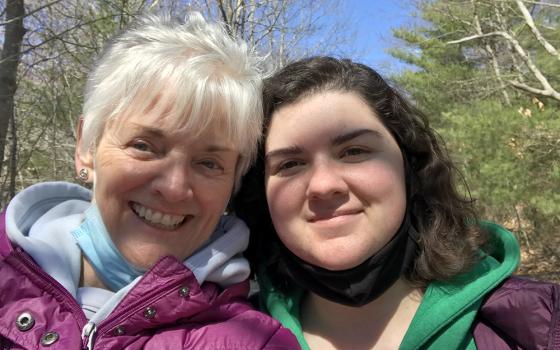
People march through the streets of Washington on July 22 to demand that the U.S. and other governments keep their promises to fund global relief programs for those living with HIV and AIDS. (CNS/Paul Jeffrey)
World AIDS Day is Saturday, and as it approaches, it's important to take a moment to remember the millions of people who have lost their lives to AIDS and to reflect on the advancements that have been made in the last decade toward achieving an AIDS-free world.
The President's Emergency Plan for AIDS Relief (PEPFAR), which marks its 10th year in 2013, has played a transformative role in the global fight against AIDS. It has effectively revolutionized HIV/AIDS treatment in the developing world, making antiretroviral drugs available on a massive scale and saving millions of lives in the process.
Before PEPFAR, a diagnosis of HIV for someone living in a developing nation was usually viewed as a death sentence. Now, thanks to PEPFAR and the many programs it supports, people living with HIV can manage the disease and lead a full, productive life. In fact, efforts to control the disease have been so successful that the global fight against HIV/AIDS is now at a major inflection point.
The HIV/AIDS challenges developing countries will face in the next decade is quite different to those they have grappled with in the last ten years. Instead of needing to focus on triage and on treating large numbers of critically ill people, these countries will need to work out how to provide ongoing health care to millions of HIV-positive citizens, many of whom will live into old age, and on finding ways to continue to reduce the frequency of new infections, particularly among children.
An estimated 3.4 million children under the age of 15 are living with HIV/AIDS worldwide. More than 90 percent of HIV-positive children live in Sub-Saharan Africa. This year, about 230,000 children will die of AIDS-related causes. If we are ever to live in a world free of AIDS, the rate of infection among the youngest and most vulnerable must be dramatically reduced.
During my time in Africa, I saw the horrendous impact HIV has on children firsthand. On one visit to Zambia, I encountered Janet, an 11-year-old girl who lived in a rural area, about 25 miles from the nearest health facility. I was struck by how severely stunted Janet was, so much so that her 6-year-old sister was taller than she was. Stunted growth is a typical sign of chronic malnutrition, but it can also be caused by other things, including HIV. A test revealed that Janet was indeed HIV positive, a condition she had been unknowingly living with since birth.
It may sound strange, but Janet is one of the lucky ones. Unlike millions of her HIV-positive peers who don't find out they're infected until it's too late, she learned of her status and received treatment.
So how do we make sure children like Janet receive the care and services they need to stay healthy? And how do we stop more children from contracting the disease in the first place?
The answer can be summarized in one word: partnership. If we're to eradicate HIV among the world's children and achieve a world free from the clutches of this terrible disease, national governments, medical professionals, corporations, local community leaders, nonprofits and faith-based organizations -- including the church -- must pool their resources, expertise and ingenuity.
One tremendous example of the power of partnerships is the UN-sponsored program to stop the transmission of HIV from pregnant mothers to their children. The program's goal is to reduce the number of new HIV infections among children by 90 percent and the number of AIDS-related maternal deaths by 50 percent by 2015. Communities of faith, civil society, nonprofits, the private sector, international development organizations and people living with HIV all work together with the UN and the U.S. government on this effort. Each group makes a different yet equally important contribution to the cause, helping to bring us one step closer to the program's ambitious goals one step at a time.
Partnerships have always been fundamental to the success of The Catholic Medical Mission Board. For the last century, our organization has worked in collaboration with hundreds of individuals and organizations, including pharmaceutical companies, national health systems, local community leaders and other nonprofit organizations. Partnerships with the communities themselves as they tackle the challenges of children living positively are of utmost importance. It's what sustains and inspires us and what enables us to provide quality health care to millions around the world.
As people across the globe show their support for the fight against HIV, we at The Catholic Medical Mission Board reaffirm our commitment to working with all our partners -- present, past and future -- to tackle the next phase in the fight against the global HIV/AIDS epidemic. An AIDS-free world is an ambitious goal. It's also an achievable one if we work together.
[Bruce Wilkinson is president and CEO of The Catholic Medical Mission Board.]



